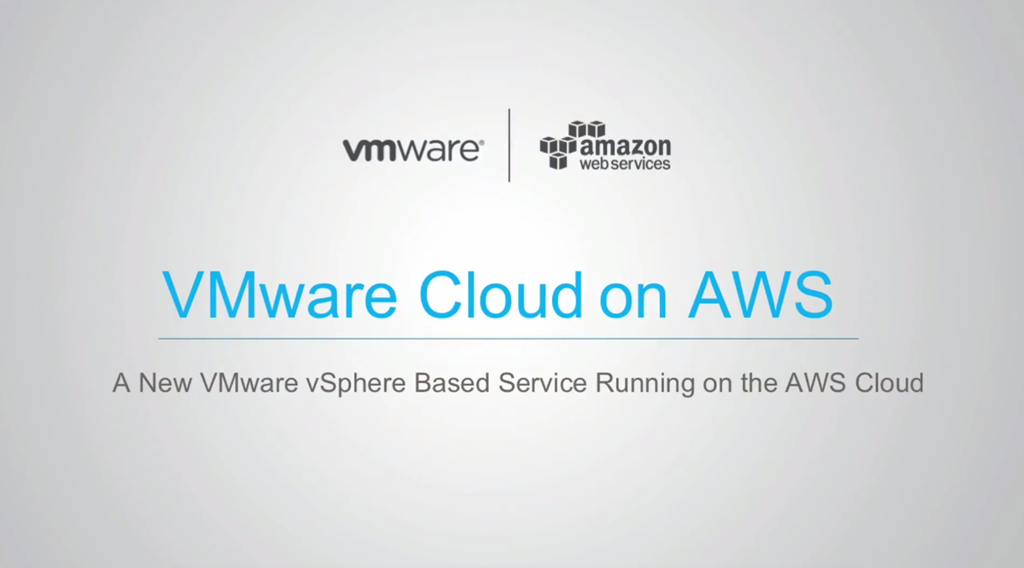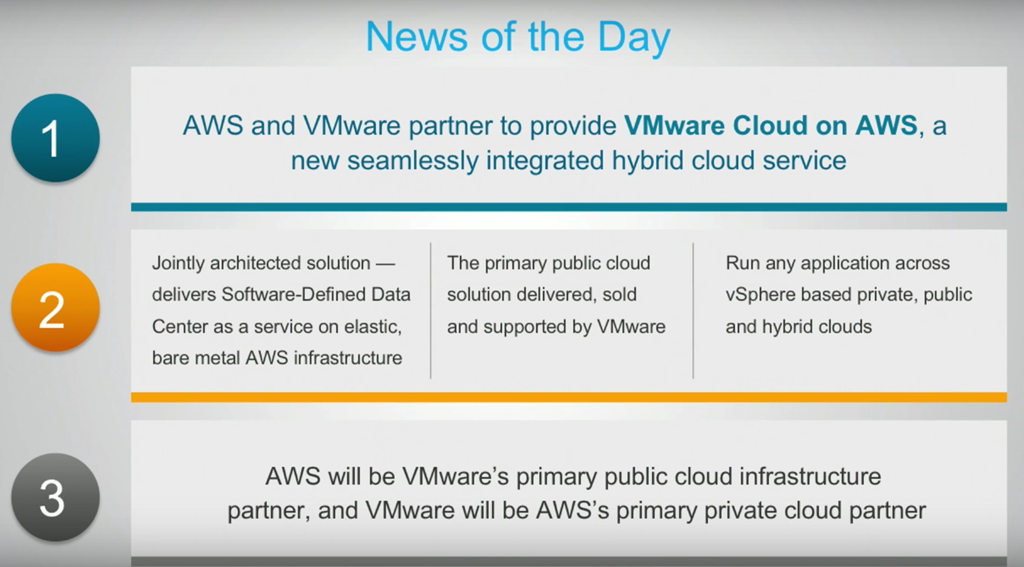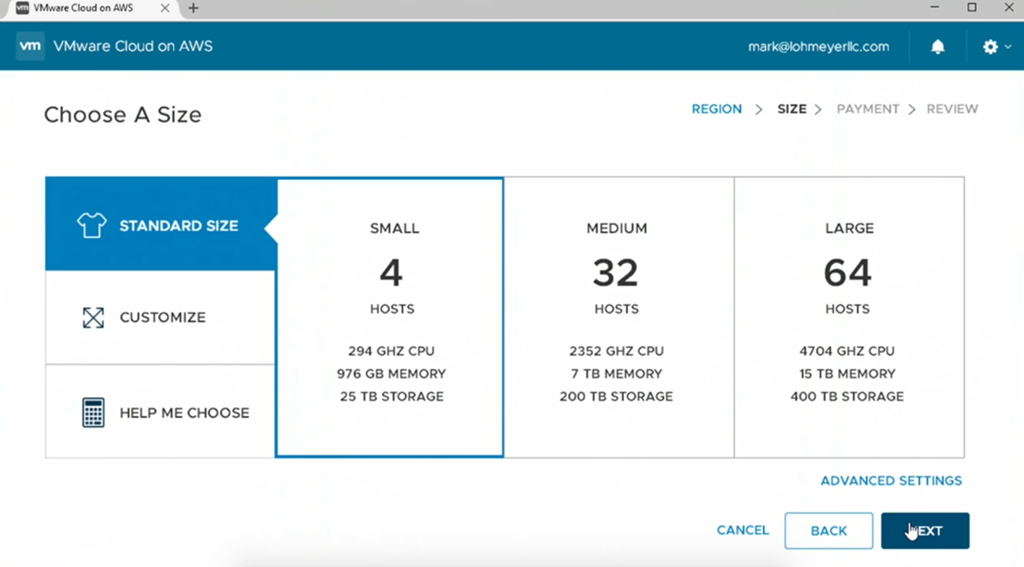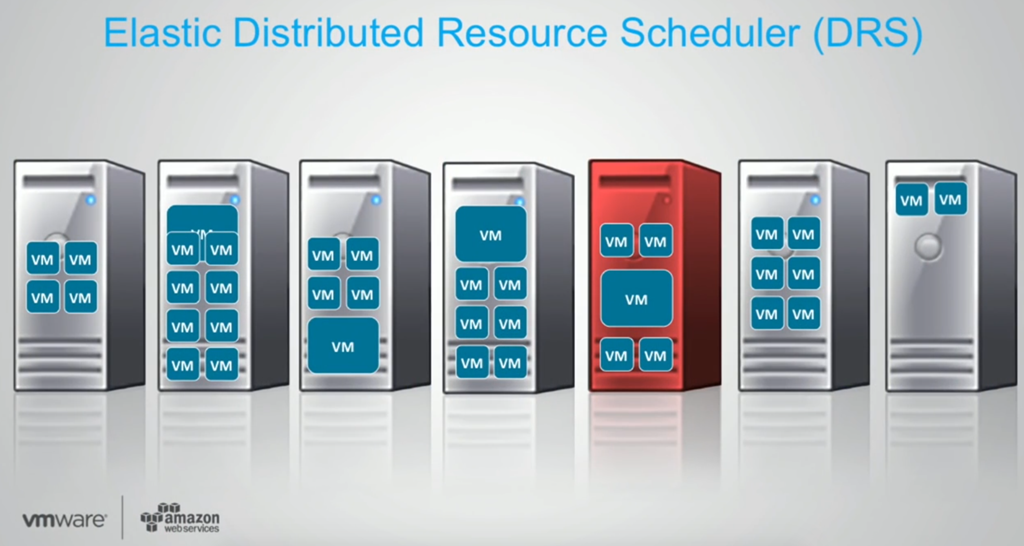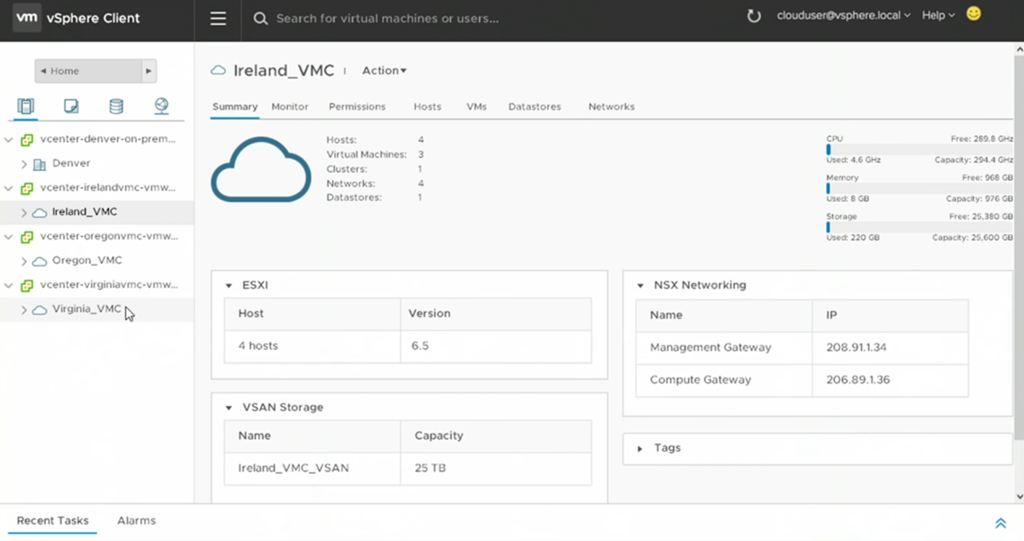VMware on AWS - My Thoughts
The world shook a few days ago, with the announcement of a partnership between VMware and AWS.
There are a number of posts that have been released, by a number of bloggers and analysts, about what this actually means but I would like to highlight 3 of them, and also insights from the Joint announcement and my thoughts on the matter as whole.
- VMware and Amazon Web Services Announce Strategic Partnership (Charu Chaubal)
- VMware Cloud on AWS – A Closer Look (Frank Denneman)
- In the Works – VMware Cloud on AWS (Jeff Barr)
So first some history, VMware has always perceived AWS as a competitor. It is no secret that VMware over the years (https://gigaom.com/2013/03/01/vmware-stick-with-us-because-amazon-will-kill-us-all/) have warned their customers about going to AWS. Some of the claims included (but not only):
- Why this is bad thing.
- One way ticket – vendor lock-in
- Enterprise workloads are not suitable
- The list goes on.
VMware even has (or had) specific playbooks and marketing decks that were used to explain to their customers why vCloud (or vCloud Air) was a much better choice that AWS.
So first facts.
The Announcement
-
An integrated hybrid cloud service.
To me that means that I can move my workloads from my on-premises Private Cloud to a Public Cloud Provider – and in this case it would be AWS.
One thing that should be made clear off the bat.
The offering that was announced – is not a hybrid solution. What VMware is offering is the option to place your workloads either in your on-premises Private Cloud or in another Private Cloud which is located in a 3rd party Datacenter – in this case – AWS. VMware are trying to position and sell as something that it is not.
You are not making use AWS as a cloud provider – all you are doing is using them as a 3rd party bare metal provider.
-
Jointly Architected Solution
Yes there was some work needed on both sides. But honestly – I think the work was almost completely on the part of VMWare, and hardly any investment on the part of AWS. Let me explain why.
If you look at what AWS offers today, they are not adding, removing, or changing anything at all in their infrastructure to accommodate this offer. Perhaps they are ensuring that there will be enough capacity to run the solution – but nothing besides that has to change.
It could be I am wrong – but this is how I would envision how the product would work.
Once a new Cloud is ordered (see screenshot from Demo below) VMware will go and request the appropriate bare metal hosts from AWS – by invoking an API, install ESXi on the hosts and then provision all the additional building blocks on top of it. I assume that a lot of the work that will bring up this infrastructure will be using the work and the expertise of the people in Project Zombie which already is being used (I hope) for building up vCloud Air.
What does AWS have to do allow this solution to work? Nadda, it already exists – anyone can request a bare metal server.
On second thought, I may be exaggerating – they probably did and will provide an AMI (Amazon Machine Image) with ESXi readily installed – to make things move a bit faster.
(An interesting tidbit of info that comes out this relationship, that the AWS proprietary hardware – will now be certified to run ESXi)
So if we look again. What effort was needed on AWS’s part – I assume the AMI image (perhaps some other background stuff – which we do not know about). From the VMware perspective – writing the code to call the correct AWS API’s for the bare metal nodes, the code to provision all the nuts and bolts on the servers and of course let us not forget the required work that went into certifying the proprietary AWS hardware that they use. If you are aware of it – or not, AWS builds their own hardware in direct partnership with hardware manufacturers, they don’t run brand names. At the scale they are functioning – it does not make sense.
(So just as side bit of information – unless this is a specialized version of ESXi – it might be – but I assume that the changes will make it into the default code base at some point because maintaining a specific branch, just for AWS does not make sense. In the future you probably will be able to deploy your own bare metal node from AWS and install ESXi on it – all on your own – without the service from VMware. It will not be as polished as the service provided by VMware – but it should be possible. Once they have opened this Pandora’s box – it will be hard to close it)
-
Primary Public Cloud Solution – delivered, sold and supported by VMware
So as I said above – this is not really a public cloud solution solution – this is a Private cloud running on a Public Cloud on AWS – who are the suppliers are the bare metal servers. Is this way AWS are no different than any other vendor who provides the same service.
They are not offering a public cloud solution running on top of AWS. They are not offering the option for you to deploy a Cloud solution that you will be able to sell to your customers. It is a vSphere ,VSAN and NSX environment that you use to your hearts desire. Your applications can use all of AWS’s other services – you cam already do that today – without running VMware on AWS.
But it is not a Public Cloud.
-
Run any application across vSphere based Private, Public and Hybrid Clouds
Finally something I can agree with!!
-
AWS will be VMware’s primary Public cloud infrastructure partner, and VMware will be AWS’s primary private cloud partner
So this one is interesting.
Firstly, if I was a VMware vCloud partner – I would be very, very worried because there is no-one that can compete with the scale of AWS, and a statement like this one – saying that we have one main partner would put dampers on other partners. For example the partnership announced just over two months ago with IBM (https://www-03.ibm.com/press/us/en/pressrelease/50420.wss).
The other side of the equation of AWS using VMware as a private cloud partner – is not something that I would take too seriously. AWS has always and still believes that everything should run in the Public cloud.
What does AWS have to gain from this? Absolutely everything!!!
VMware are trying to position this offer as a way to start using AWS resources – not with any kind of integration mind you – because from the information currently made available – there is no special integration done with VMware to make use of the AWS resources. Yes the announcement said they will be able to use AWS services – but it also was stated that the benefit here will be the proximity to AWS resources in each location – nothing more. That is a huge plus but then again, this is something that anyone can do today, running from within AWS or running from with their own datacenter. It is just a matter of proximity, not any technological advantage.
In addition – when VMware users start learning about the plethora of available services that they can use while in AWS they will see that it might start to make sense to use them natively – without running first on VMware.
The above screenshot was from Jeff Barr’s blog post, which I think points towards the future direction and why AWS were ready to accept this with open arms.
They view the workloads that will run in VMware on AWS as old fashioned, historical applications (and there will always be a need for such applications). And when you the User are ready to grow up and move forward to the future – we are ready to help and will accept you with open arms, you are already half the way there.
The same as well when you are interested to scale your application – then we have the capacity and the geographical spread to help you out. Just know that running it on VMware might not be your best bet.
I am sure they are betting on the fact that once they have the workload in an AWS datacenter – the path for migrating off of VMware into AWS native will not be so scary.
Elastic DRS
Technologically speaking this is being made out be a much bigger feature than it really is. For a shop that is heavily into automation – how hard is it to actually scale up your cluster? Honestly – I think the biggest thing would be to order the actual hardware, rack it and stack it. The rest of it really trivial, installing ESXi, Host profiles and adding it to a cluster – is all something that we know how to do, and if we really did some work, automate it up the wazoo.
This is a very simple thing to now to do for VMware in this solution – all they need to do is make an API call to provision a new bare metal server and do all the magic behind. No more rack and stack, no more waiting for hardware to arrive – no more doing things the old way. They have a theoretically infinite supply of hardware to run VMware workloads – so this makes perfect sense.
The Demo – was just that – a Demo
The demo showed the provisioning of an environment in AWS.
There is no way in hell, ever, that a 4 host cluster with VSAN and NSX, could be provisioned in less than 3 minutes. The installation of all that software – including vCenter (especially vCenter) is not that fast.
I would suppose that it would take an hour or two to actually provision all the pieces to get it up and running.
(So just for purposes of bike shedding, do you start paying per hour – from the time that you click go – or from the time that the resources are fully available)
Cost
Last but not least – the matter of how much this is going to cost.
There is no denying that this is going to open up a huge amount of options to people who previously were limited in scale because of power, space, hardware limitations, etc.
But this is not going to be cheap. And let us all be honest – the amount of people that are going to use this as on per-hour basis – is going minimal. The majority of customers will use this on a regular basis – trying to maximize the resources they can use for the lowest cost possible.
Doing the math on the amount of CPU and RAM available in the cluster size offered in the demo – it seems that the Dedicated Host type will probably be a an M4.
The monthly cost of an M4 (without even putting any VMware software on it is $1451.90 x 4 servers – means we are looking at ~$6,000 for hardware alone per month.
I assume that VMware are going to want to factor into this the costs of licensing and operations – remember – this is a fully managed service that you are getting (which also brings up a question – how much control do you have over the underlying infrastructure, I assume none).
The current cost for a vCloud host (Dedicated Cloud) is just short of $6,000 per month – without support. I can envision that VMware manage to keep the costs more or less the same as they have up until now – but it will definitely be a good idea to run a proper cost-analysis to see if this is something that will be good for and your organization.
Summary
AWS will be the ones to benefit the most from this in the long run.
VMware are making this out to be a much bigger deal than it actually really is.
As always – please feel free to leave your thoughts and comments below.

